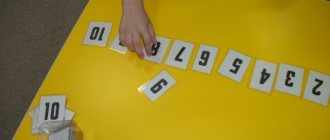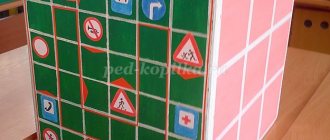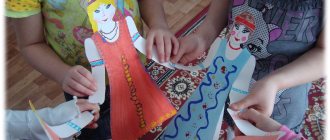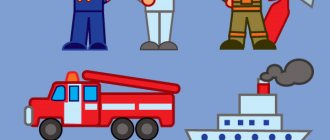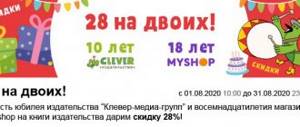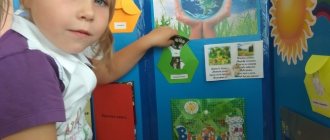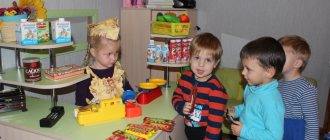Catalog of games for children of senior preschool age to develop a food culture
DIDACTIC GAMES
"Vitamin Billiards"
Goal: to consolidate knowledge about ways to maintain your health, about the vitamin value of foods, about the effect of vitamins on the body.
“Magic saucepan”, “Let’s cook borscht (cabbage soup, fish soup).”
Goal: to consolidate ideas about preparing first courses.
“Where does porridge grow?”
Goal: to consolidate ideas about the origin of food products (cereals, flour), their benefits for the body, and the dishes in which they are included.
"Let's reap the harvest."
Goal: to consolidate the general concepts of “fruits” and “vegetables”.
"Wonderful bag."
Goal: development of tactile sensitivity when identifying vegetables and fruits by touch, consolidating the idea of the benefits of fruits and vegetables.
“What first, what then?”
Goal: strengthening the skills of sequential serving of dishes when eating for breakfast, lunch, dinner.
"Helpful - harmful."
Goal: to consolidate ideas about the beneficial and harmful properties of products for health.
"Field of Dreams".
Goal: to consolidate ideas about vegetables and fruits, about the influence of vegetables and fruits on the human body.
"In the fruit kingdom, vegetable state."
Goal: to reinforce the idea that human health depends on nutrition.
"Right wrong".
Goal: to reinforce the rules of behavior during meals.
“Who lives in the house?”
Goal: familiarize children with the components that make up food products: fats, proteins, carbohydrates, vitamins; revealing their role in human life.
"Vitamin House"
Goal: to consolidate ideas about the types of vitamins and vitamins contained in foods.
“Call it in one word.”
Goal: strengthening the ability to classify vegetables and fruits.
“Help Katya the doll pick out the dishes for the tea party (dinner).”
Goal: to consolidate ideas about tea and tableware, the concept of “tea pair”.
“Lay out the cutlery.”
Goal: developing the ability to use cutlery.
“Pick a picture.”
Goal: to consolidate the ability to use cutlery correctly.
"Find the right picture."
Goal: strengthening skills related to eating.
ROLE-PLAYING GAMES
“Visiting grandma (Winnie the Pooh, Winx fairy, Cinderella).”
Goal: to consolidate ideas about the rules of etiquette and food culture.
"Kindergarten".
Goal: expanding children's ideas about the profession of a cook and assistant teacher.
"We have guests."
Goal: to consolidate ideas about the rules of communication culture, about the rules of food culture.
"Supermarket. Products".
Goal: to arouse children’s interest in the sales profession; developing skills for a culture of behavior in public places; consolidating children's knowledge about healthy and harmful foods.
"Children's Cafe".
Goal: to consolidate ideas about the culture of behavior in public places, the culture of eating, and the diet of children's food.
“Mothers and Daughters”, “Family”, “Home”.
Goal: consolidation of ideas, development of skills about the rules of table setting for a family holiday.
BOARD AND PRINTED GAMES
“Sort out the dishes.”
Goal: consolidation of ideas about dishes for various purposes; development of skills to properly set the table.
“It grows, blooms and ripens.”
Goal: to consolidate ideas about vegetables and fruits.
"Part and whole."
Goal: to consolidate ideas about food.
“Fold the picture.”
Goal: to consolidate ideas about various products.
"Lotto".
Goal: fixing the names of the products.
"Opposites".
Goal: to consolidate ideas about the taste of products.
FINGER GAMES
Goal: consolidation of ideas about products, rules of food culture; development of fine motor skills, memory, speech and motor coordination, imagination, artistry.
- "Forty-forty."
- “Let’s salt the cabbage.”
- “Finger-boy, where have you been?”
- "Shchi cabbage soup - Counting table."
- “We clean the vegetables for cabbage soup.”
- "Fingers in the garden."
- "Grandma's jelly."
- “I bake, bake, bake.”
- "We shared an orange."
- “Give me some milk, Buryonushka!”
- "Cat Chef"
THEATER GAMES, DRAMATIZATION GAMES
"Riddles without words."
Goal: consolidation of ideas about vegetables and fruits, development of expressive facial expressions and gestures.
“Let’s play and guess” (according to A. Bosev).
Goal: consolidation of knowledge about food products, development of pantomime skills.
“How the soup was made.”
Goal: to consolidate ideas about how and from what products the first course is prepared; development of imagination and pantomime skills.
“I don’t want semolina porridge!”
Goal: consolidation of ideas about the rules of communication culture, the rules of food culture, improvement of intonation means of expressiveness.
“The milk ran away” (according to M. Borovitskaya).
Goal: to consolidate knowledge about the benefits of dairy products; development of pantomime skills.
Pantomime game “The hare had a garden” (according to V. Stepanov).
Goal: consolidation of knowledge about vegetables and fruits, development of pantomime skills.
"Tart yellow lemon turns into sweet blood orange."
Goal: consolidation of knowledge about vegetables and fruits; development of expressiveness and imagination.
"The transformation of Pierrot into Malvina."
Goal: consolidation of ideas about the rules of etiquette; improving creative independence in conveying an image; consolidation of food culture skills.
"Cooks."
Goal: to consolidate ideas about how and from what products various dishes are prepared; development of expressiveness and imagination.
Pantomimes: “I am a cheerful tomato”, “I am an evil lemon”, “Bitter pepper”.
Goal: to consolidate knowledge about vegetables and fruits, about the influence of vegetables and fruits on the human body.
Dramatization game: “Riddles in the garden beds” by R. Baradulin.
Goal: consolidation of ideas about the rules of etiquette at the table; development of skills to play with literary texts.
Games are “repetitive”. “My grandma and I will buy...”
Goal: to consolidate the rules of a culture of behavior in public places, to consolidate children’s knowledge about healthy and harmful products, to develop the ability to act simultaneously, equally and in concert with other participants.
Musical-ri, “Turnip”, “Fly - Tsokotukha”.
Goal: to consolidate ideas about vegetables and fruits, ideas about rational nutrition, to consolidate ideas about the rules of table setting, etiquette at the table; the formation of abilities to perceive musical images and expressive transmission in movements, the ability to act together.
Puppet theater "Three Bears".
Goal: to consolidate ideas about the rules of table setting; development of creative abilities.
"Visiting Kolobok."
Goal: to consolidate knowledge that bakery products are baked from flour.
“Feed the Bear.”
Goal: strengthening the skills of setting the table for dinner, improving eating skills.
"Lessons of Malvina."
Goal: consolidation of knowledge about etiquette at the table.
“Feed Masha some porridge.”
Goal: to consolidate ideas about the rules of table setting for breakfast.
"Visiting Pyatochka."
Goal: consolidation of ideas about the rules of behavior in society, about food culture.
"The dolls are drinking tea."
Goal: to consolidate ideas about the rules of table setting for tea drinking, about the rules of behavior at the table.
OUTDOOR GAMES
"Green Apples"
Goal: to consolidate ideas about fruits; development of abilities for motor-figurative transformation, development of movements.
"Let's play with vegetables."
Goal: to consolidate ideas about vegetables; development of movements; formation of coordination and spatial orientation.
"Let's play with the fruit."
Goal: to consolidate ideas about fruits; improving skills in running and jumping on two legs (“picking fruit”).
"Reach for the apple."
Goal: to consolidate ideas about the benefits of fruits; improving high jumps.
"Across the bridge - for mushrooms."
Goal: to consolidate ideas about the benefits and harms of certain products; improving coordination of movements, sense of balance.
"Baba was sowing peas."
Goal: to consolidate ideas about legumes; developing the ability to move in a circle, jumping rhythmically on two legs.
"Let's hide in the house."
Goal: to consolidate the general concepts of “fruits”, “vegetables”; development of visual, auditory, tactile sensitivity in the process of motor activity.
COMPUTER GAMES
Goal: consolidation of knowledge about food products, the origin of food products; strengthening skills in using cutlery; development of cognition, logic, thinking, attention, memory, imagination.
"Edible - inedible."
"Find the vitamin."
“Which one do you like?”
Remove the unnecessary” (choose the right products and remove the harmful ones),
"Riddles about vegetables."
“Set the table”, “Dishes”, “Assemble the service” - table etiquette
MAGAZINE Preschooler.RF
Card index of didactic and outdoor games to educate food cultureMunicipal autonomous preschool educational institution "Kindergarten No. 29"
educational field "Cognitive development"
Made a selection and implemented it: Marina Aleksandrovna Sabirova, teacher in Berezniki, 2020.
Card index of didactic and outdoor games
on education of food culture
Goal: Instilling a culture of nutrition
- "Helpful - harmful"
- "Together - Separately"
- "Wonderful bag"
- “What can be prepared from these products?”
- “What grows where?”
- "Let's Harvest"
- "Journey to the country of Vitaminia"
- "Magic Pan"
- "Vitamin ABC"
- “Brew borscht”
- "Tops and Roots"
- "Right wrong"
- "Helpful - harmful"
(game for children from 3 to 7)
Goal: to consolidate knowledge about healthy and harmful products.
- Children 3-4 years old are given pictures depicting food products (up to 4-5 items). They must lay them out on a panel divided into 2 parts. Healthy foods are placed in the first white half, and unhealthy foods are placed in the red half. The game is played after the conversation.
- Children 4 years old are given pictures depicting 5-8 names of food products. The pictures hang on a string, around the neck. Children move around the area (run, walk, jump), at the signal “Stop” they stop and are distributed to that part of the area that corresponds to the picture (healthy products - white cord, harmful - red cord).
- Children 5-7 years old perform the same tasks, but line up in columns in accordance with the color of the flag: white - healthy foods, red - harmful.
"Together - Separately"
Goal: to consolidate ideas about product compatibility.
Children 5-7 years old receive cards with string. They depict food products. First, the children move (run, jump, walk), at the signal “1, 2, 3 - find a partner ,” the children become paired with the one who has a product compatible with his picture. Whoever gets a pair stands on a cord laid out on the floor.
“What grows where?”
(game for children 5-7 years old)
Goal: to consolidate children’s knowledge of where certain food products grow.
Children sit or stand in a semicircle, the teacher is in front of them. It shows one picture each of vegetables, fruits, bread products, butter, cheese, etc. Children must guess where they grow up.
Options: “Who will tell you more?”
- "Tops and Roots"
- "Wonderful bag"
To acquire and consolidate knowledge about dishes prepared from certain products, you can organize a game with a set of pictures depicting food products.
First, children select pictures for a particular salad, then the second course (for example, cutlets, cottage cheese casserole, etc.) and lastly the third courses.
"In the kitchen"
(for children 5-7 years old)
Purpose: to teach children to classify “products” for cooking.
Children are divided into 3 teams. Each of them prepares one of the dishes of her choice (pictures are selected). can “cook” this or that dish faster Then the children change places and “cook” other dishes.
“Brew borscht”
(for children 4-5 years old)
Purpose: to give children an idea of how to prepare soup, consolidate knowledge about vegetables, cereals, etc.
Children are given a set of pictures depicting the products needed for borscht.
Children, as directed by the teacher, place the appropriate products into the pan in a certain sequence.
Options: “Let’s make pea soup” , “Pickle soup” , “magic saucepan” , “What can be prepared from these products”, etc.
"Let's Harvest"
(for children 3-7 years old)
Goal: to consolidate general words: fruits, vegetables, the ability to arrange them in appropriate containers.
The teacher scatters pictures on the floor and ground, for example, depicting fruits and vegetables. At the signal “1, 2, 3 - collect fruits, vegetables,” children collect fruits in a vase or basket (a vase or basket with slots is drawn).
"Right wrong"
(for children 3-7 years old)
Goal: to consolidate the rules of behavior for children during meals.
The game is played by analogy with the game “Helpful - Harmful” . Children approach the table, on which there are upside-down pictures depicting correct and incorrect behavior at the table during meals, and stand on 2 sides of the hall or playground. Some go to the left if they think that the correct behavior is depicted there, others stand opposite.
To reinforce ethical skills, you can play the game “What first, what next?” , in which children need to arrange the pictures on the table in order, for example, first wash their hands, sit down at the table, check with their fist or palm whether the chair is correctly pushed to the table, then wish bon appetit to their neighbor at the table or to all the children sitting at this table. Take bread, a proper spoon (fork) and start eating. Help with bread to take food into a spoon (fork). When eating the second dish, you need to separate small pieces from the large one and, taking it into your mouth, chew them well. Do not talk while chewing. Watch your seating position with your hands (elbows should not be on the table). If it is difficult to get something on the table, politely ask a friend to bring bread, a napkin, etc. When eating soup, do not place onions or other foods on the edges of the plate. When there is little soup left in the plate, you need to throw the plate away from you and finish the contents. After eating, wipe your lips with a napkin and rinse your mouth.
It is good if these rules are reinforced in practice. During meals, teach children to observe them and, in some cases, remind them of some rules of etiquette. When eating, you can use proverbs about etiquette or about the products from which a particular dish is prepared.
Sample proverbs used during meals.
- Good nutrition is the foundation of health.
- Food is the basis of life.
- As is the food and drink, so is life.
- Eating wisely means living long.
- The food tastes better at a communal table.
- At lunch, eat little, at dinner, eat less, because the health of your body is forged in the forge of our stomach.
(M. Cervantes)
- Food that is not digested eats the person who ate it. Therefore, eat in moderation, so that what you eat can be digested. (Abul Faraj)
- Eating in abundance harms the body just as abundance of water harms crops.
- The simpler the food, the more pleasant it is - it does not become boring, the healthier it is, and the more accessible it is always and everywhere. (L.N. Tolstoy)
- Eat little and you will be full for a long time; eat a lot and you will quickly become hungry. (Vietnamese)
- Eating little can drive away many diseases. (Arab.)
- The more a person eats, the more gluttonous he becomes.
- Anyone who can barely breathe from fat is not healthy.
- Do not accustom your belly to two breads, and your body to two caftans.
- We do not live to eat, but we eat to live. (Socrates)
- Walk - don't stagger, talk - don't stutter, eat - don't overeat, stand - don't sway.
- Be moderate in your eating and fast in your walking.
- You need to eat and drink so that it’s not hard to walk.
- The leaner the food, the more pleasant it is to sleep.
- The lighter the food, the better the sleep.
Proverbs about vegetables and fruits.
- Vegetables are a source of health.
- Greens on the table - health for a hundred years.
- A handful of parsley is equal to a handful of gold.
- Lunch without vegetables is like a holiday without music.
- Onions and cabbage won't be allowed in.
- I ate carrots and a drop of blood appeared.
- Early greenery will not allow disease.
- Fruits and vegetables are the music and poetry of nutrition.
- Cabbage is the number one vegetable.
- Potatoes protect bread.
- Where there is no meat, beets are a hero.
- He who eats grapes drinks the condensed sun.
- Those who don’t know the way to the vegetable garden well know the way to the doctor.
- Eat an apple and refresh your teeth.
- Sugar destroys teeth, but carrots strengthen them.
- Nettle is called: green pantry, forest fairy, healer, nurse, dietary product, green cosmetics.
- Onion from seven ailments.
- Onions are a friend to health.
- Onions and garlic are siblings.
- May grass also heals the sick.
- The queen of vegetables is cabbage.
- Sweet foods are not always healthy.
- Expect trouble from sweet food.
- Sweets are the enemy of teeth.
- A little sweet - no bitterness to the point of tears.
- Excessive sweetness is worse than bitterness.
- To whom sweets are friends, his teeth are enemies.
- The fewer sweets a child has today, the more joys he will have tomorrow.
Topics of conversations about nutrition:
- "Introduction to the Digestive System"
- "About Bread"
- "About Sugar"
- "How to behave at the table"
- “Can vegetables harm our health?”
- What did they like to cook in Rus'?
- "Our great-grandmothers' favorite drinks".
- Alyamovskaya V.G. and others. A child at the table: A manual on the formation of cultural and hygienic skills. – M.: TC Sfera, 2006.
- Tikhomirova L.F. Exercises for every day: Health lessons for children 5-8 years old - Yaroslavl: Academy of Development, Academy Holding, 2003.
| Next > |
Didactic game “Helpful - Harmful” material on the topic
Didactic game
"Harmful and useful"
Goal: To expand children's understanding and consolidate children's knowledge about the dangers and benefits of food, form the foundations of a healthy lifestyle and valeological culture, expand the vocabulary of preschoolers, develop communication skills, attention, memory, hearing, and speed of reaction.
Preliminary work: In educational activities and during regular hours, conversations are held on the topic: “Harmful and healthy foods”, “Our health”, “What helps us grow healthy”, etc. Children also look at and, together with the teacher, discuss illustrations and story pictures on these topics, and also participate in watching cartoons and programs about a healthy lifestyle.
Before starting a game in the middle group, children must be reminded of the rules of the game. In senior and preparatory classes, 1-2 times are enough for the kids to remember the rules. Therefore, you can simply name the game you are going to play with them. At the end of the game, praise the children for their attention and correct answers, wish them and yourself good health.
Option 1 - for the middle group
Children sit on chairs. The teacher has in his hands 5-7 pairs of cards depicting harmful and beneficial products (or human actions). For example: “Vegetables”, “Chips”, “Children play in the fresh air”, “A child is sitting at the computer, and it’s night outside”, “A child washes his hands with soap”, “A grimy child”, etc.
The teacher shows the cards one by one and names what is shown on them. If it is a useful product (or action), children clap their hands and say “Yes, yes, yes!” And if it’s harmful, then the guys stamp their feet and, saying “No, no, no!”, shake their heads negatively. First, you can alternate between bad and good, and then complicate the task by showing, for example, how useful products (actions) are in a row, and then one that is harmful. You must end the game with a positive example.
Option 2 - for the older group
a) The conditions are the same as in the younger group, but the teacher does not show pictures, but names a product or action.
b) Children can sit freely in the playroom (or on the playground). When the teacher names a useful product (or action), the children walk, clap their hands and say “Yes, yes, yes!” And when it’s harmful, they stop, shake their heads negatively and say “No, no, no!” The game ends with a positive example.
Option 3 - for the preparatory group
a) The conditions are the same as in the previous groups, but the children have red and green cards in their hands (any shape of card). The teacher shows a picture (or names a product or action). Positive option - children pick up green cards, negative option - red cards.
b) Children sit in the playroom on the carpet (or on the playground). They have red and green cards in their hands. Music sounds, the guys start moving - walking, dancing, etc. The teacher stops the music and shows a picture of a product or action. When the music ends, the children stop and, depending on the version of the picture, show the red one, saying “This is bad!” or a green card, saying “This is very good!”. A more difficult option is when the teacher does not show pictures, but names a product or a person’s action. The game uses 5-7 pairs of card options or names.
